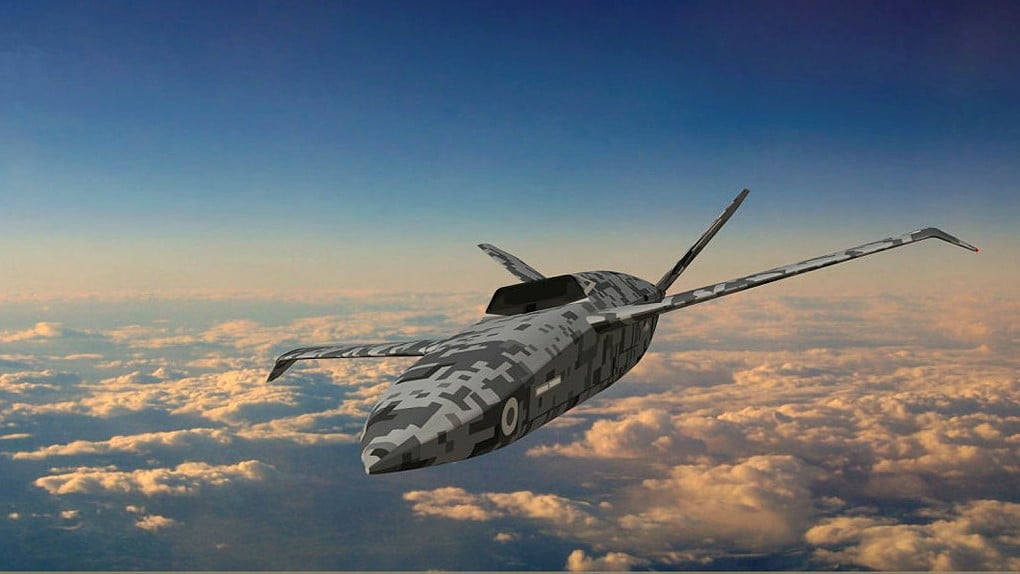
Computer Generated Image of the Lightweight Affordable Novel Combat Aircraft (LANCA). (UK MoD)
LONDON: Project Mosquito, the Royal Air Force’s future uncrewed combat aircraft technology demonstrator, is dead. But the RAF is already moving forward with plans for what might come next, service officials said this week.
On June 24, the RAF’s Rapid Capabilities Office announced the cessation of Mosquito, confirming it would not proceed beyond the design phase. Tasked with the design of a “loyal wingman” for the RAF’s F-35B, Project Mosquito was part of the Lightweight Affordable Novel Combat Aircraft (LANCA) program, and had been scheduled to fly by the end of 2023, supported by a consortium of US firms Northrop Grumman and Spirit AeroSystems, along with UK company Callen-Lenz.
At the time of cancellation, Air Commodore Jez Holmes, head of the Rapid Capabilities Office, stated that “Through Project Mosquito and other experimentation activities the Royal Air Force has made substantial progress and gained significant value in understanding and harnessing a range of future uncrewed capabilities.
“Deciding to not proceed with the specific manufacturing technology demonstrator will not impact on the wider intent to build the most capable and cost-effective force mix possible, or the ‘Loyal Wingman’ concepts under investigation within the Future Combat Air System (FCAS) enterprise. The program remains focused on the post-2035 capability space, where integration through a system-of-systems approach has been a key requirement from the outset,” he continued.
Holmes then suggested the air service would “quickly launch activities to aggressively pursue the RAF’s unchanged [and] firm commitment to integrate advanced uncrewed capabilities into the near-term force mix with more immediate beneficial value.”
It turns out when Holmes said “quickly,” he was serious. Addressing delegates at the Global Air and Space Chiefs’ Conference in London on July 14, Air Chief Marshal Sir Mike Wigston, Chief of the Air Staff, shed light on future plans.
“The work has been challenging, but we have learnt and gained a huge amount from our Mosquito program around digital design and novel manufacturing techniques. We’ve decided that our focus now should be on systems that can be operationalized much more quickly, and that is why we have drawn the Mosquito program to a close.
“But we are moving on fast and I’m delighted to announce that in the Autumn we’ll unveil a series of targeted challenge areas that we want to drive forward at pace, with industry, our science and technology partners, and internationally too. So look out for our Rapid Capabilities Office who will launch a series of industry competitions to accelerate scalable uncrewed systems, culminating in an operational ‘fly-off’ to get those systems on the frontline, delivering for the warfighter faster and better,” Wigston said.
What kind of technologies will be looked at? Per Wigston, they will include “a mix of swarming drones and uncrewed combat aircraft, as well as next-generation piloted aircraft like Tempest,” the UK’s still-in-design next-gen fighter program.
“Our swarming drone trials point to the enormous operational potential for these systems to confuse and overwhelm an adversary’s air defenses. In the last 3 years, 216 Test and Evaluation Squadron alongside the Rapid Capabilities Office, Defence Science and Technology Laboratory and industry will have trialed five drone types in 13 different trials of new payloads, new platforms and new control systems,” he continued.
According to Wigston, the RAF is also exploring new models of capability delivery and accelerated production “when we need them” rather than “in case we need them.”
Examples include the twin jet 3D-printed Pizookie as well as other undisclosed “commercially-available large drones fitted with novel payloads” and large quadcopters.
“In light of this work, I can announce that we declared on the March 28 this year, that 216 Squadron has demonstrated an operationally useful and relevant capability, using the RAF’s current fleet of drones,” he announced before confirming further exploratory UAV work to “augment” F-35 and Typhoon jets.
In a media roundtable at the event, Wigston also explained how the RAF had reached a “review point” in the Mosquito program.
“We took a long look and we decided that we got a lot out of Mosquito. And we had thought a lot about modern manufacturing, resin injection and some really interesting manufacturing techniques or automated manufacturing techniques.
“We’ve learned a lot about digital design and air worthiness clearances and all of those things that we will need to get our heads around. But we realized that actually, we’re going to field very rapidly to the warfighter at a cost that we could scale up. We were not going to achieve those goals in the timeframe that I wanted. I wanted to stop it quickly, learn from it quickly and move on.
“And that’s what the competitions that we’re going to launch in September, October will be about and there’ll be a number of different areas, but we will specify in particular for operational use cases and we will be much more focused on a rapid delivery to the warfighter and it will be the Mosquito type autonomous combat vehicle,” Wigston concluded.






















